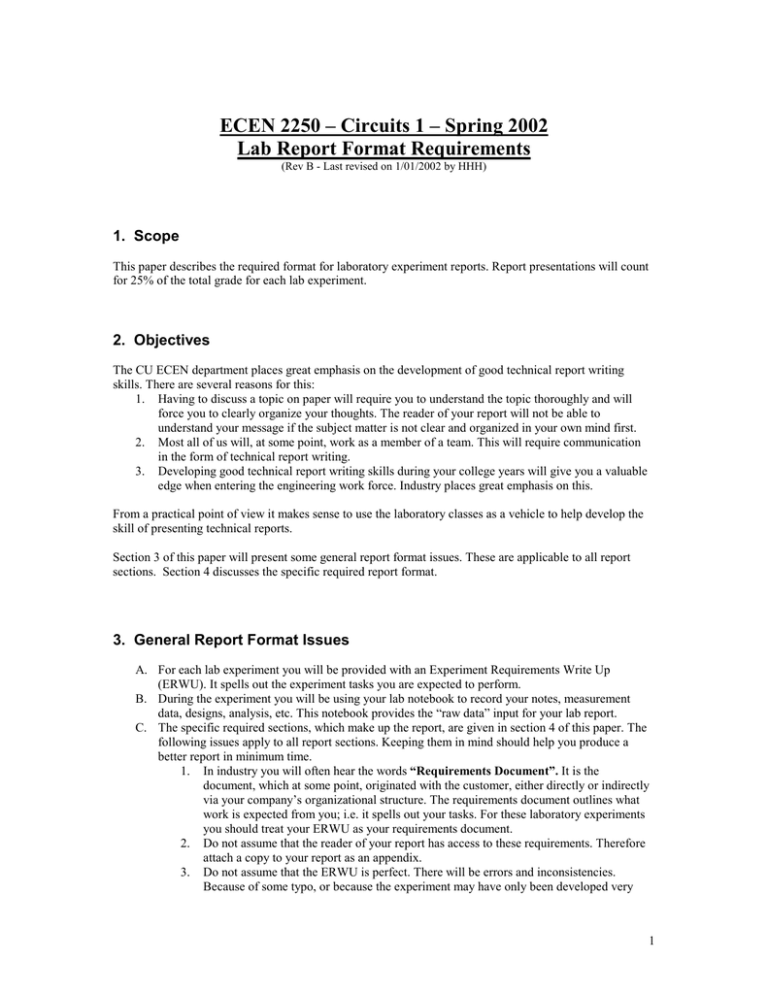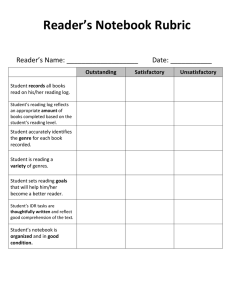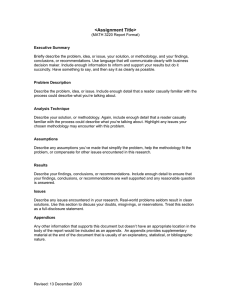Circuits 1 Lab – Fall 2000
advertisement

ECEN 2250 – Circuits 1 – Spring 2002 Lab Report Format Requirements (Rev B - Last revised on 1/01/2002 by HHH) 1. Scope This paper describes the required format for laboratory experiment reports. Report presentations will count for 25% of the total grade for each lab experiment. 2. Objectives The CU ECEN department places great emphasis on the development of good technical report writing skills. There are several reasons for this: 1. Having to discuss a topic on paper will require you to understand the topic thoroughly and will force you to clearly organize your thoughts. The reader of your report will not be able to understand your message if the subject matter is not clear and organized in your own mind first. 2. Most all of us will, at some point, work as a member of a team. This will require communication in the form of technical report writing. 3. Developing good technical report writing skills during your college years will give you a valuable edge when entering the engineering work force. Industry places great emphasis on this. From a practical point of view it makes sense to use the laboratory classes as a vehicle to help develop the skill of presenting technical reports. Section 3 of this paper will present some general report format issues. These are applicable to all report sections. Section 4 discusses the specific required report format. 3. General Report Format Issues A. For each lab experiment you will be provided with an Experiment Requirements Write Up (ERWU). It spells out the experiment tasks you are expected to perform. B. During the experiment you will be using your lab notebook to record your notes, measurement data, designs, analysis, etc. This notebook provides the “raw data” input for your lab report. C. The specific required sections, which make up the report, are given in section 4 of this paper. The following issues apply to all report sections. Keeping them in mind should help you produce a better report in minimum time. 1. In industry you will often hear the words “Requirements Document”. It is the document, which at some point, originated with the customer, either directly or indirectly via your company’s organizational structure. The requirements document outlines what work is expected from you; i.e. it spells out your tasks. For these laboratory experiments you should treat your ERWU as your requirements document. 2. Do not assume that the reader of your report has access to these requirements. Therefore attach a copy to your report as an appendix. 3. Do not assume that the ERWU is perfect. There will be errors and inconsistencies. Because of some typo, or because the experiment may have only been developed very 1 recently, it may even be asking you to perform 10000 measurement data points instead of 10. When these types of problems surface, they are not an excuse for you to not do the experiment. You are responsible for bringing up these issues to your TA or instructor. In industry you are expected to identify inconsistencies and errors in the requirements document. In fact, many of you will at some point have the opportunity to convince a customer to change her/his mind while at the same time make him/her think that they actually came up with the idea. (Remember: the customer is always right, even when she/he is not). 4. Keep the amount of words to a minimum. You are not writing a novel. You are trying to convey technical information. Use single spacing. A large amount of paper DOES NOT impress. It most likely will result in your report not being read at all. However, do include all the important material; i.e. focus on the quality of the content and not the quantity. 5. Hit the key points with numbered bullets so you can refer back to them easily. 6. Make liberal use of pictures (schematics, block diagrams, etc.), tables and plots. They get the attention of the reader much easier and much more effective then words. Each picture, table and plot must have a figure/table/plot number and a title. 7. Give units for all parameters and variables. 8. Use appendices for raw measurement data, derivations and other analytical work. The main body should simply show the major “in-between” results and the final “bottom line” outcome. 9. When referring to an appendix, be specific. If an appendix has 10 pages, don’t expect the reader (the grader) to find, or even bother finding, a reference if you do not give at least a page number. 10. Explain acronyms. A simple but acceptable approach is to use the full meaning the first time with the acronym in parenthesis, e.g. Experiment Requirements Write Up (ERWU). 11. Avoid relativistic terms without giving a frame of reference. Descriptions such as “the current was very large”, “the voltage was very low”, and “this experiment is very important” are meaningless unless you give some type of reference. 12. Provide a title page with the class name and number, your lab section number, the experiment number, the date, and the names of the author(s). Provide an index page. Number your pages. 4. Specific Report Format • • In industry you will probably see many types of reports. Their formats will vary as dictated by purpose, intended audience and other criteria. However, they will likely have many similarities. The format, which you will be using, is outlined below. It has evolved over several decades in several branches of the industry. You should refer back to this format prior to each lab report activity. 1. Scope • • State the area or subject matter covered in the lab experiment in one or two lines. The information for this will most likely come directly from the title of the ERWU. 2 2. Objective • • • The ERWU will give an outline of the tasks and goals of the experiment. You can use this information to state the experiment objectives in a few numbered lines. What are you trying to accomplish? What are the results you are hoping to achieve? Give a short summary of the report contents and its organization. 3. Experiment Description • • • • • • Give a layout of the experiment. This should be in a clear logical order and should not be a playby-play description (i.e. do not use “we did this, then that, then that, etc”). When practical (and it usually is) follow the sequence of the stated objectives. Discuss pre-lab simulations and analysis. Explain the meaning and significance of any equations used for analysis. Their derivations, when necessary, should be relegated to an appendix. Identify any underlying assumptions. Describe lab hardware setup and measuring equipment. Make use of illustrations using schematics and hardware setup diagrams. Define all variables and parameters, including their units. Explain what measurements you are going to do and how they are going to help you in meeting the stated objectives. 4. Results • • • • • • Give three sets of results: analytical, simulated and hardware measurement results. Include and describe simulation data and lab measurement data and explain their meanings. Label all results. Include only results, which focus on meeting the stated objectives; i.e. do not include any unsuccessful attempts. These belong in your lab notebook. Use figures where appropriate. These must be labeled, properly captioned and not excessively crowded. The axis labels must include variable names and units. When the experiment involves analytical calculations and simulations (typical pre-lab activities), you should present these results, together with the hardware measurement data, in table format. One of the major goals of these lab experiments is for you to see that these three results will in general be different (to within expected tolerances). Finding out why an unacceptable difference occurs is an important part of engineering. (Using simulations to identify hardware “anomalies” is becoming a major trouble-shooting tool in engineering). 5. Discussion • • • • • • • • • Highlight the main points of the report. Relate results to objectives. Correlate analytical, simulated and measured results. Discuss the differences. Give specific answers to the post-lab questions. Discuss significance and limitations of the experiment. Discuss things that you uncovered (debugging tips, analysis approach, etc.) Identify things that you would do differently next time. Identify unresolved issues. Identify any key points for possible future follow-up work. 3 6. Conclusions • In one or two lines identify the most important conclusion that may be drawn from your experiment. 5. A few final remarks • • • • • • Keep your report as short as possible. This cannot be stressed enough. Again, you will need to include all the important material, but focus on quality and not on quantity. Don’t wait until the last minute to write your report. A good report takes a concentrated effort. If you are in a “rushing” mode, your report will suffer (and at that moment in time the printer will fail, the server will crash, your computer gives up, etc. By now you have all been there and done that). In many industries your reports form the final product of your efforts. They very often will determine how your expertise is perceived in the eyes of your customer, your management, your peers and, more important, your teammates. In such situations your report becomes your calling card. In my 35 years as a practicing engineer I have yet to find a tool, which more forced me to thoroughly understand a technical topic, than writing about it. This is even truer if the report is intended for a technical audience. A technical audience seems to have a “give no quarter and take no quarter” attitude. In front of a technical audience there is no hiding. Any arm waving will be caught. The moral: don’t arm wave and keep digging until you thoroughly understand all issues associated with your report. If in the end there is something you do not understand, then say so. Do not try to bluff your way out of it. Be very careful with “quick on the draw” statements. Very often they are in error or incomplete because you did not think the issue through. It also displays an attitude that in general is not well received by your reading audience. Save your reports. They may someday come in handy for a job interview. 4

